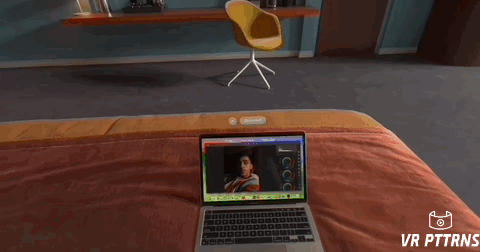Mac Virtual Display for Vision Pro
Feature description:
From Apple: “Bring your Mac wirelessly into Vision Pro with Mac Virtual Display. You can place it anywhere in space and use Vision Pro as an enormous, private, portable 4K display.”
Best practices employed:
◉ Virtual environments present their own set of challenges, encompassing physical constraints and human cognitive capabilities. Sudden and unexpected alterations in the environment can induce discomfort, thereby undermining the overall immersive experience. As the well-being of users takes precedence in any encounter, health-related issues can be detrimental to the success of augmented reality.
◉ A key component of a successful AR user experience lies in aligning mental models with the actual system. In the realm of virtual environments, the utilization of hands, interactions, and in this case glances/saccadic eye movement assumes paramount importance. The design elements and actions should be crafted in such a manner that users are not required to engage in unfamiliar or unnatural movements. Prioritizing natural actions and interactions is consistently advisable, as it fosters user comfort and cultivates a sense of familiarity throughout the experience.
◉ As seen here motion design in a 3D space is cleverly aligned with gestural interaction design and eye tracking to make it clear that the screen is being mirrored from the Macbook. The screen ’emerges’ out of the Macbook and sits above it prompting the user to ‘pick it up and place it’, scaling it to the desired size. This approach avoids depth cue issues by initially attaching, or anchoring, the virtual screen above the Macbook screen providing real depth.
◉ As the Vision Pro does not use virtual hands, but rather real hands in an AR environment, it appears that issues with proprioception (awareness of the position of the body and limbs) are largely overcome.
◉ It appears that the gestures used are similar to those used on other Apple devices e.g. the iPad, iPhone and the Macbook trackpad providing cohesion between mental models and the actual model used in visionOS, increasing comfort and familiarity.
◉ A high frame rate via the powerful M2 chip should reduce any dizziness or vertigo (through abnormal stimulation of the vestibular system) that could be induced by judder.

